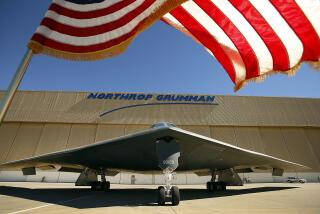Rockwell: A Giant in Defense and Aerospace
- Share via
With 1988 sales of more than $11.9 billion, Rockwell International is the 28th-largest U. S. corporation and one of the world’s largest defense and aerospace contractors.
The company’s Rocketdyne Division, based in Canoga Park, last year produced revenue of about $1 billion.
Rocketdyne has about 8,900 employees nationwide, with more than 8,100 of them working at its Canoga Park plants on Canoga and De Soto avenues, the Santa Susana Field Laboratory southeast of Simi Valley, and at office buildings in Westlake Village and on Plummer Street in Chatsworth.
Occupying 2,668 acres on a rugged plateau in the Simi Hills, Santa Susana was established in 1947 as a rocket testing site. In those days, the company was known as North American Aviation Co., becoming Rockwell International after a merger and a name change in 1973.
Since the late 1970s, Rockwell has run the U. S. Department of Energy’s Energy Technology Engineering Lab at Santa Susana, mainly to test non-nuclear components of nuclear power plants.
Soil Cleanup
Today, most nuclear work at Santa Susana involves cleanup of contaminated soil and buildings from past activities.
But in the 1950s and ‘60s, Santa Susana was a major nuclear research and development site. Beginning in 1956, 16 nuclear reactors were built and operated there, with the last shut down in the early 1980s.
Most of the reactors were very small, and a company official said about 10 of them were about the size of a 55-gallon drum. The largest, known as the sodium reactor experiment, suffered a partial fuel melting accident in 1959. It had a capacity of 20 million watts, making it still far smaller than a commercial nuclear plant.
From about 1960 until 1986, Rocketdyne also had government contracts to “declad” nuclear fuel, part of the process of recycling it for use in defense programs. The decladding, done in a heavily shielded “hot cell,” involved mechanically slicing or breaking open highly radioactive fuel rods, and removing and packaging uranium, plutonium and other radioactive materials.
The recycled fuel was then sent to the Department of Energy’s Savannah River nuclear weapons plant in South Carolina and to the Idaho National Engineering Laboratory, which produces fuel for the nuclear Navy.
Lack of Contracts
The work stopped in 1986 for lack of new contracts, but Rocketdyne hopes to compete for future decladding work. It is seeking renewal of its federal Nuclear Regulatory Commission license needed for work in the hot cell.
Rocketdyne’s plants on Canoga and De Soto avenues were completed in 1955 and 1959, respectively. Each housed a small nuclear reactor for a time--the Canoga plant in the ‘50s and the De Soto plant until the mid-’70s.
Nuclear fuel was also fabricated at De Soto under government contracts from 1959 until the early ‘80s.
The Canoga plant uses radioactive materials in industrial radiography to examine rocket engines. Radioactive sources also are used to study the effects of cosmic rays on computer chips.
At the De Soto plant, Rocketdyne has a gamma irradiation cell to test the effects of radiation on electronic equipment.
More to Read
Inside the business of entertainment
The Wide Shot brings you news, analysis and insights on everything from streaming wars to production — and what it all means for the future.
You may occasionally receive promotional content from the Los Angeles Times.










